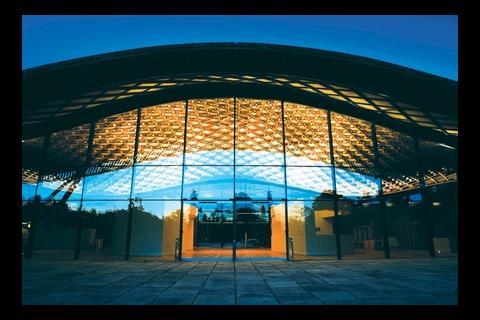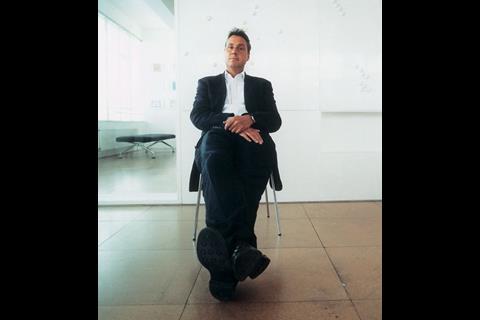Robert Plant, Ozzy Osbourne, Noddy Holder ⊠the Midlands has produced its fair share of rock stars. Sadly, frustrated musician Glenn Howells wasnât one of them. But now, with a Stirling prize nomination to his name, the Birmingham architect is about to get his turn in the limelight.
Once upon a time, when the young Glenn Howells still harboured dreams of making it as a guitarist, he had a brief encounter with Richard Rogers.
Howellsâ band was playing at a smart country club in Devon, when the great man turned up at the door with his wife, Ruthie, and tried to get in.
âThere was a bit of a kerfuffle at the entrance, so I went to see what the trouble was,â he recalls. âThe club was run by two rather camp men and I heard one of them say âI donât care which famous museum youâve designed in Paris â youâre not coming in!ââ
Today Howells is a great admirer of Rogersâ work but sitting behind a white table in his Birmingham studio, he cracks up, sighs and rests his head in his hands, still chuckling.
He likes telling stories â thereâs an anecdote to accompany every major event in his life, including how he came to win a place on this yearâs Stirling prize shortlist for the first time. The winner will be named on 6 October.
He is nominated alongside star architects such as Norman Foster and Rem Koolhaas.
A betting man could be forgiven for considering him a long shot, but he is fast becoming a force to be reckoned with. The project he is shortlisted for, the Savill building in Windsor Great Park, has been hailed for combining modern design with natural, locally-sourced materials.
âWe found out that the client, Crown Estates, produced a lot of timber so we started having conversations with carpenters,â he says. âWe eventually went into the presentation with an entourage of carpenters and a model of the building, saying we wanted to weave a canopy out of the wood, mound the landscape and end up with a piece of poetry. And they went for it.â
Howellsâ passion for woodwork was ignited at the age of five, when he began accompanying his father, a carpenter, to building sites in the Black Country.
âHeâd take me along to give my mum some time off,â he says. âHeâd hand me a plank of wood with half-knocked-in nails all the way along and my job for the day would be to bash them all in and hand back the wood.
I didnât have wooden toys as my playthings â I had actual lumps of wood.â
Howells took a year out after school to give the music business a try. Realising he was never going to hit the big-time (âI was in a terrible band called Ponderosa where everyone was so old I was the only one without a vasectomyâ) he changed tack after he saw an advert in music magazine NME for the Plymouth School of Architecture. He applied, went for an interview and was offered a place on the spot.
After nearly failing his diploma â he blames postmodernism, or âshowmanship with a bit of half-baked thinking behind itâ as he saw it â he worked for a few years in south-west England before heading to London just in time for the 1990s recession.
He joined the practice of Robin Spence (nephew of Sir Basil). As the recession started to bite, and fewer and fewer projects were coming into Spenceâs office, Howells realised he had to set up on his own. A friend in Plymouth provided him with his first solo commission â a refit of a Chinese restaurant. Times were so hard, he says, that he strung the job out for a year. By then he no longer survived on fees, but on Chinese food.
At this admission, Howells sits back in his chair and looks around the huge meeting room, possibly marvelling at how far he has come since that first job. The view from the window takes in most of Birminghamâs major projects. From one window, there is Howellsâ own Rotunda building for Urban Splash. Out of another, Future Systemsâ Bullring shopping centre glistens in the autumn sun. From a third, you can see Ian Simpsonâs Beetham Tower.
Outside the room, bright young things buzz about the place. It looks like an architectâs office in a film â big open spaces with whitewashed walls, located in a grimy inner-city neighbourhood. To get there, you have to pass discount furniture shops, fast-food joints and junk yards.
The location is significant, as it is down the road from Howellsâ first ârealâ commission â the Custard Factory, an arts and media space that is regarded as pivotal in Birminghamâs regeneration.
That scheme, he says, is the reason his practice is based in Birmingham, with a much smaller office in London. It is where he grew up and where he began life as an architect.
As one of the drivers of the cityâs regeneration, Howells was recently asked by the council to look at the âvision of the city and how it physically presents itself to the outside worldâ. He was also instrumental in commissioning a masterplan for the city centre, awarded to Urban Initiatives last month.
He says his dedication to Brum is actually the reason he didnât take part in the masterplan competition, despite being invited by several of the bidding teams.
âI felt I could be useful to the place not by bidding, but being part of the conversation about how to take it forward,â he claims. âIâve been keen since 1995 that the place should have a clear idea about where it is taking itself. Itâs too big to be left to chance.â
On the record, he is self-consciously upbeat about the cityâs regeneration progress. âWhatâs tantalising about Birmingham is that it should be, and I think it will be, fantastic â a really important European city,â he says.
Behind closed doors, however, sources say he has been known to vent frustration at the lack of progress, which he believes is because of council politicking.
Howells is not as diplomatic when it comes to other citiesâ projects. He sits on Cabeâs design review panel for the London Olympics and is happy to join the chorus of designers apprehensive that the venues will be poorly designed owing to lack of funding.
âIt is really important that what gets left behind is not undermined by a failure of nerve,â he says. âThe organisation has to hold firm, take a breath and have the confidence to face up to the procurement issues.â
Lack of funding didnât stop Howells realising his vision for Windsor Great Park. âWe lost about ÂŁ180,000 making the Savill building,â he laughs. Of course, a Stirling nomination is a powerful consolation. âWhen we found out we had made it down to the last six, we popped the champagne.â
The practice is taking four tables at the awards ceremony in London next month, at a cost of more than ÂŁ10,000, which will be mostly filled with subcontractors from the project. âAll the people we bothered at the outset are now insisting on coming along, even if they have to pay for themselves,â he says, adding wryly, âItâs going to be a very disappointed coach on the way back.â
The Savill building deserves to win, he says, because of the care and attention that has gone into the building. But he remains convinced that a project in Germany will be the judgesâ favourite on the day â either Fosterâs Dresden station redevelopment or David Chipperfieldâs Museum of Modern Literature in Marbach am Neckar.
He pauses, then pulls a rabbit-startled-in-the-headlights face: âIâm practising my thrilled but disappointed look for the night.â
Glenn Howellsâ portfolio
Completed
Savill building in Windsor Great Park for Crown Estates; Timber Wharf in Manchester for Urban Splash; the Luna șÚ¶ŽÉçÇű in London for Berkeley Homes; Aspex Gallery in Portsmouth for Aspex Visual Arts Trust; Southside in Birmingham for Crosby Homes; Market Place arts facility in Armagh for Armagh council.
On the books
Rotunda in Birmingham for Urban Splash; Snow Hill in Birmingham for Ballymore Properties; Eleven Brindleyplace in Birmingham for Argent; London 2012 Olympic village for First Base; the regeneration of Elephant & Castle for First Base; city masterplan for Stoke-on-Trent.
Wonders, blunders, books
Whatâs your favourite building?
The Iron Bridge in Coalbrookdale, Shropshire, is one of the most daring and beautiful metal structures in the world, partly because it shows in its smallest details the imagination and skill in connecting metal, often adapting earlier carpentry connections.
And least favourite?
A testament to unimaginative engineering combined with the wrong brief, New Street Station has presented the worst first impression of this terrific city for a generation. Rebuilding New Street presents a huge opportunity to create a world-class arrival for passengers and to reconnect the city centre for pedestrians at its heart.
Who would play you in the film of your life?
Anyone except Tom Hanks
Whoâd be your desert Island companion?
Jayne (my partner) and if no family are allowed, Jack the dog who listens to me
Favourite books?
Archangel by Robert Harris; The English Terraced House by Stefan Muthesius
Postscript
For the latest on the run-up to the Stirling prize, check
























No comments yet